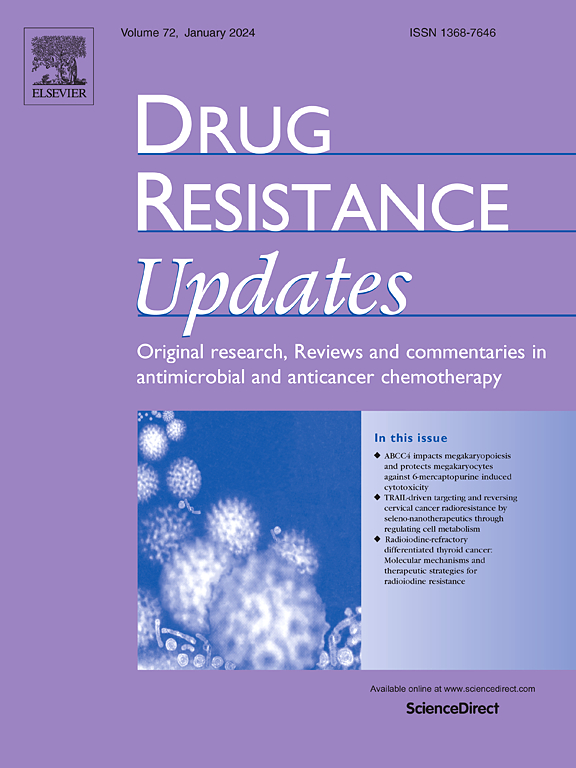Targeting cTRIP12 counteracts ferroptosis resistance and augments sensitivity to immunotherapy in pancreatic cancer
IF 15.8
1区 医学
Q1 PHARMACOLOGY & PHARMACY
引用次数: 0
Abstract
Aims
Current therapeutic strategies for pancreatic ductal adenocarcinoma (PDAC) have limited efficacy in increasing patient survival rates, largely due to ferroptosis resistance and immunosuppression. The aim of this study is to identify molecular mechanisms associated with ferroptosis resistance and immunosuppression in PDAC tumour cells.
Methods
Circular RNA sequencing (circRNA-seq) was performed on clinical samples to identify potential circRNAs that mediate ferroptosis resistance. C11-BODIPY staining, FerroOrange staining, the glutathione ratio, malondialdehyde quantification, and transmission electron microscopy were employed to assess ferroptosis. RNA pulldown, mass spectrometry, RNA immunoprecipitation, and coimmunoprecipitation assays were conducted to investigate the molecular mechanisms involved. A HuNSG mouse xenograft tumour model was utilized to validate therapeutic agents.
Results
A circRNA derived from TRIP12 (cTRIP12) was identified in PDAC samples resistant to ferroptosis. cTRIP12 knockdown increased the sensitivity of PDAC cells to ferroptosis and immunotherapy. Subsequent mechanistic studies revealed that cTRIP12 specifically binds to the O-linked N-acetylglucosamine transferase (OGT) protein and increases intracellular O-GlcNAcylation levels, leading to increased protein levels of ferritin heavy chain (FTH) and PD-L1 in tumour cells. Notably, high cTRIP12 expression suppressed ferroptosis sensitivity and increased immune resistance in PDAC cells by functioning as a protein scaffold through its interaction with OGT and protein kinase R-like endoplasmic reticulum kinase (PERK). cTRIP12 inhibition induced ferroptosis in PDAC cells by reducing FTH and PD-L1 expression and synergistically increased the immunotherapy efficacy. In vivo animal experiments confirmed that the triple therapy consisting of GSK2656157, erastin, and anti-CTLA-4 effectively suppressed the progression of PDAC in tumours with high cTRIP12 expression.
Conclusion
We elucidated the molecular mechanisms underlying the simultaneous occurrence of ferroptosis resistance and immune suppression in PDAC patients. Our study provides a novel therapeutic strategy that could promote ferroptosis in tumour cells and increase immunotherapy efficacy.
求助全文
约1分钟内获得全文
求助全文
来源期刊

Drug Resistance Updates
医学-药学
CiteScore
26.20
自引率
11.90%
发文量
32
审稿时长
29 days
期刊介绍:
Drug Resistance Updates serves as a platform for publishing original research, commentary, and expert reviews on significant advancements in drug resistance related to infectious diseases and cancer. It encompasses diverse disciplines such as molecular biology, biochemistry, cell biology, pharmacology, microbiology, preclinical therapeutics, oncology, and clinical medicine. The journal addresses both basic research and clinical aspects of drug resistance, providing insights into novel drugs and strategies to overcome resistance. Original research articles are welcomed, and review articles are authored by leaders in the field by invitation.
Articles are written by leaders in the field, in response to an invitation from the Editors, and are peer-reviewed prior to publication. Articles are clear, readable, and up-to-date, suitable for a multidisciplinary readership and include schematic diagrams and other illustrations conveying the major points of the article. The goal is to highlight recent areas of growth and put them in perspective.
*Expert reviews in clinical and basic drug resistance research in oncology and infectious disease
*Describes emerging technologies and therapies, particularly those that overcome drug resistance
*Emphasises common themes in microbial and cancer research
 求助内容:
求助内容: 应助结果提醒方式:
应助结果提醒方式:


